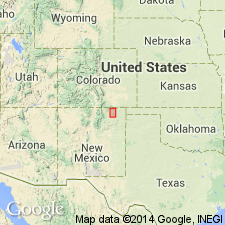
- Usage in publication:
-
- Clayton Basalt*
- Modifications:
-
- Geochronologic dating
- Overview
- AAPG geologic province:
-
- Las Vegas-Raton basin
Summary:
Is middle (of three) basaltic to latiandesitic effusive rock unit mapped in western part of Raton-Clayton volcanic field, Colfax Co, NM in Las Vegas-Raton basin. Includes olivine basalt, trachybasalt, trachyandesite, and latiandesite. Flows stand out about 100 to 400 ft above major drainage. In hand specimen, rocks are black, dark to medium gray, fine to medium grained, porphyritic and mostly dense. Flows are more scoriaceous than the older Raton; some have a silvery sheen, some have obvious flow structure, and some show well-formed to crudely formed columnar joints; some contain xenoliths (most are rhyodacite). Is more phenocryst rich than the Raton; phenocrysts include olivine, augite, plagioclase, and less commonly orthopyroxene and oxyhornblende; xenocrysts of quartz and feldspar are sporadically present. Petrography and petrochemistry described. Age is Pliocene and Pleistocene. K-Ar ages range from 1.27 +/-.71 m.y. to 0.66 +/-.12 m.y. Age range of 2 to 0.5 m.y. is inferred from geomorphic evidence.
Source: GNU records (USGS DDS-6; Denver GNULEX).
For more information, please contact Nancy Stamm, Geologic Names Committee Secretary.
Asterisk (*) indicates published by U.S. Geological Survey authors.
"No current usage" (†) implies that a name has been abandoned or has fallen into disuse. Former usage and, if known, replacement name given in parentheses ( ).
Slash (/) indicates name conflicts with nomenclatural guidelines (CSN, 1933; ACSN, 1961, 1970; NACSN, 1983, 2005, 2021). May be explained within brackets ([ ]).

